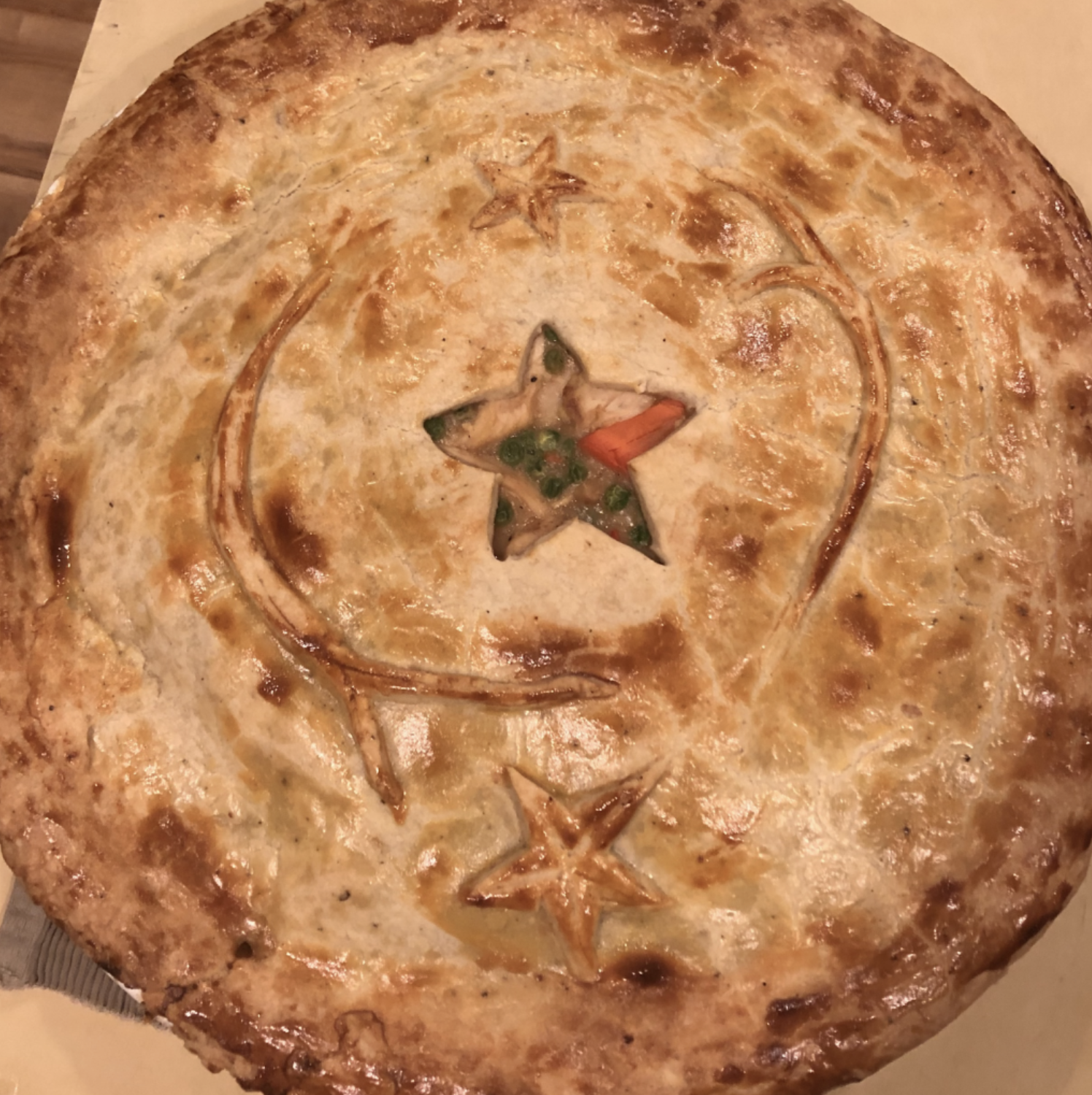Giant Chicken Pot Pie with Savory Pie Dough
If you know, or learn how to make pie dough, you have an amazing opportunity to look at left overs in a whole new light! Meat pies have been around for a long, long time, and they won’t be going anywhere anytime soon – largely because they are awesomely comforting and very delicious! While most think of pot-pie as a landing pad for left-over chicken or turkey, you can put just about anything in a pot pie. From left-over pot roast, to chicken tikka masala, a meat pie is a great way to stretch your left-overs by adding some excitement.
The cool thing about the meat pie approach is that you can customize the seasonings in the pie dough to add extra ‘wow!’ factor. For instance, if you want to use left-over chicken tikka-masala, add garam masala and chili spice to the dry ingredients for your savory pie dough. You can also use this same dough as a hack for cultural favorites like Jamaican Patties or Empanadas. With a variety of options ranging from different shapes, fillings, and seasonings, the possibilities are endless — as will be the compliments you get!
Ingredients
2 separate batches of savory pie dough recipe – make sure you make one pastry disk about 10% larger than the other so the bottom crust compensates for the depth of the sides of the baking dish you choose
2 tablespoons room temperature butter
2 quarts turkey gravy
2 to 3 quarts of left-over vegetables – potatoes, sweet potatoes, roasted carrots, cooked broccoli, etc.
2 quarts left-over turkey
Steps
Pre-heat your oven to 375 degrees
Set your dough disks out 10 to 15 minutes at room temperature before rolling-out the dough. (Savory Pie Dough Recipe below)
Use a pastry brush to butter the bottom, sides and lip of your chosen baking dish, which doesn’t have to be a pie tin – it can be a large glass casserole, a roasting pan, etc.
Roll-out the larger dough disk into a shape that will fit your chosen baking dish (detailed instructions in video)
Carefully lay the rolled-out dough into the baking dish, ensuring there are no tares. Patch and tares or holes with excess dough.
Following the instructions in the savory pie dough recipe and on the video, line the pie crust with foil and filler, then place in the oven and bake about 15 minutes, or until the dough is set.
Remove the pan from the oven, remove the foil liner and filler, then return to the oven and bake 10 to 15 minutes more.
In the meantime, place the gravy, vegetables, and turkey meat in a large sauce-pot over medium heat.
Heat until just too hot to touch.
Use a pastry brush to brush egg wash onto the lip of the cooked pie crust. This will ensure that the raw top crust will adhere to the cook bottom crust during the final baking of the pie.
Pour the warm pot pie filling into the bottom crust, then carefully place the top crust over the pie.
Gently press the raw dough into the lip of the egg wash-coated cooked dough, then place in the oven and bake 30 to 45 minutes, or until the pie reaches and internal temperature of 160 degrees.
Remove from the oven and let stand 20 minutes before serving.
Savory Pie Dough
Please, please, try making pie dough! Just once? Seriously, I’m amazed at how many people have flocked to bread baking during the pandemic. I know some of these newly-anointed bakers, and I couldn’t be more thrilled! But I also know many of these new bakers won’t touch pie dough with a ten-foot pole. Savory pies are such an incredible way to use left-overs, that it’s a technique worth learning. I’m so committed to it that I’ve provided you with both a video and a detailed recipe. And the recipe is customize-able. For chicken or turkey pie, I add chopped fresh thyme and black pepper. For beef, I add sage and black pepper. For lamb, I love to use lavender or rosemary and sun-dried tomato powder. Oh, and black pepper – in fact, I add freshly ground black pepper to all of my savory doughs.
Forgive the many words in this recipe, but I felt it important to help visualize your way through parts of the process where so many beginning bakers feel like they’ve failed when they have actually succeeded. If you don’t want to read all the words – watch the video below!!
NOTE: To make a giant pot pie, I make two batches of this recipe, and take about 10% of one batch after fraisage and add it to the other batch before patting each batch into disks and refrigerating. The bottom crust needs to be a little larger because any baking dish has sides that require extra dough for coverage. Good luck finding that tip in recipes other than this one – I’m all about transparency!
Ingredients
2 1/2 cups all-purpose flour, plus extra for rolling
1-1/2 teaspoon salt
1 teaspoon sugar
1 tablespoon chopped fresh thyme leaves
1 teaspoon freshly milled black pepper
2 sticks chilled unsalted butter, cut into 1/2-inch cubes
1/2 cup ice water, very cold
Steps
Place the flour, salt, sugar, thyme and pepper in a medium mixing bowl.
Using a whisk to stir and your wrist action to toss – do both! Stir and toss for a few seconds to ensure the dry ingredients are well mixed.
Transfer the flour mixture into a food processor and add the butter cubes.
Pulse 6 to 8 times for about 1-1/2 seconds per pulse to achieve a mixture that resembles a coarse meal. It’s ok – even preferable – if some of the butter pieces are larger, like peas or lentils.
Pulse the ice-cold water (without the ice!) slowly into the food processor using very small, quick pulses (about a tablespoon at a time) until you’ve added it all. Finish with one to two larger pulses – about a second or two each – until the mixture comes together to form a loose, crumbly dough.
Transfer the dough to a smooth, stable surface to barely knead using a method referred to as ‘fraisage:’ press the heel of your palm into the dough while smashing it across the kneading surface. Repeat this motion only four to six times, or until the dough just comes together. Watch the video! Applying this method results in a flaky crust. WARNING – do not-over knead the dough or you’ll have a tough pie crust!
Form the dough into the shape of a disc that’s a couple of inches thick. Again, if you see some small pieces and chunks of butter, congratulations! You’ve worked the dough perfectly. If you don’t see larger pieces of butter, but you were careful not to over-knead the dough, you’ll still have a good crust.
Wrap the disc of dough well and refrigerate at least 1 hour, but you can refrigerate up to a week, and freeze for even longer. If you choose to make batches of dough to freeze, just thaw for 24 hours in a refrigerator, then follow the next set of instructions.
Time to bake? Pre-heat the over to 375 degrees
Remove the disk from the refrigerator and place it on a smooth, stable surface. Let stand 15 minutes to take the chill-off of to the point where you can roll it out.
Pick the disk up and lightly sprinkle the surface with flour, then sprinkle some flour over the top of the disk.
Form fists with both hands and press-down to flatten the dough out, reducing the thickness by at least half. Use a rolling to roll the dough into circle about 1/8 of an inch thick.
If the dough starts to stick to the surface below, run a sharp knife underneath to free it-up. If it still seems a little sticky, gently fold the dough on top of itself and sprinkle a little extra flour on the surface of both sides of the dough before proceeding – this rarely happens unless there’s too much water in the dough.
Because savory pie fillings tend to be ‘wet,’ I brush my baking dish with room temperature butter to pre-cook the bottom crust, which is key if you want the bottom and sides to be firm and turn brown. Watch the video for my foil-filler trick. First, use enough aluminum foil to more than cover the baking dish and from-fit the foil to the inside of the dish.
Set the foil form aside.
Butter the baking dish, then transfer the dough into the dish and manipulate it so it fully covers the bottom and sides with no large air bubbles. It’s not uncommon for the dough to tare or split, but don’t worry, follow the video to see how to easily patch it up using water or egg wash.
Place the foil-filler inside the raw pie shell and fill it with rice, beans, or even small gravel.
Mound the rice up the sides to make sure the pressure keeps the dough against the side of the dish to the dough forms a nicely fitted pie crust that will hold its shape, and stand-up to a moist filling. It can be shallow, or even blank on the bottom. Supporting the sides is most important.
Bake the bottom dough for about 15 to 20 minutes.
Remove the baking dish from the oven, and carefully remove the foil filler, then return the baking dish to the oven and cook for about 15 more minutes to dry it out a bit more.
Remove from the oven and let stand to cool while you heat your savory pie filling. Whatever your filling, heat it until it just starts to steam. Doing this will speed-up the overall cooking time of the savory pie significantly.
Roll-out your top crust and brush the edge of the cooked bottom crust with egg wash, this is where you will be joining the bottom and top crusts together.
Fill the bottom crust with your savory pie filling, then cover with your top raw crust.
Brush the entire top crust with egg wash, cut a small hole int eh center to vent, then return the full savory pie to the oven.
Bake 30 to 40 minutes, rotating at least once, or until the top crust is well-browned.

